
by Rick O'Connor | Oct 23, 2015
Well… we have talked about the “big two”… snapper and shrimp, but there are other popular fin and shellfish harvested from the Gulf of Mexico. This week we look at my personal favorite… blue crab.
Probably like many of you out there, the very first sea creature I ever caught was a blue crab. It was with one of those classic basket traps where you baited it, lowered to the bottom where you could see, waited until a crab came for the bait, and pulled her in… GREAT fun. My parents cooked the crab, saved the shell and dated it. It sat on the cabinet above our breakfast bar for years. It was something I did every summer off the dock of the house we rented on Pensacola Beach… good times.
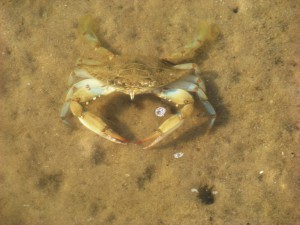
The thin telson beneath this crab indicates it is a male.
Photo: FWC
As I got older we switched from crab traps to hand-held crab nets. We would spend hours searching the grass beds around Gulf Breeze collecting and cleaning these guys. I remember cleaning over 60 of them once until my hands bled, that was about the time I thought I would let the commercial guys do this and I would just buy it from them!
As much fun as I had catching them, I had just as much fun cooking. My wife and I would make deviled crab and one of my personal favorites of hers, crab meat baked on an English muffin with cheese. Man o’ man. What a great creature the crab.
There are about 4500 species of “true crabs” found on our planet and many are valuable as a seafood product. In the Florida Panhandle it is the Blue Crab most seek out. In recent years commercial and recreational crabbers have noticed a decline in their numbers. Landings of blue crab ranged between 8 and 12 million pounds in Florida from 1982-1999 and since 2000 the landings have ranged from 4 to 8 million pounds. Researchers with the Florida Fish and Wildlife Conservation Commission have run several models to determine why the decline in landings has occurred. Though the decline in the Chesapeake may be due to overfishing, the models do not suggest this for Florida. They are not sure why the decline has happened but do have data that support the argument that freshwater discharge during heavy rain events does impact their population in a negative way. Some data suggest the increase in salinity during drought conditions has done the same. Whatever the reason, many would like to see their numbers rebound to the 12 million lb. landings we had just a few years ago.
Blue crabs typically live to be 1-2 years old, though some have been aged to 5 years. Males prefer the less saline waters of the upper estuary and the females can be found throughout the bay. Males reproduce more than once in their lives providing the females with a sack of sperm called a spermatophore. Females mate only once, just after their last molt. Once she has received the spermatophore she heads for the mouth of the bay where the water is more saline, she may enter the Gulf of Mexico searching for the right habitat. When she fertilizers her eggs they remain with her as a mass on her underside; the egg mass resembles a sponge. The larva hatch from this mass and go through several development stages as they re-enter the estuary and begin the cycle again.
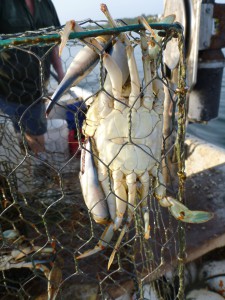
Whatever the reason for their decline, and recent increase in price, these crustaceans remain a Gulf coast favorite and I for one hope they remain around for a long time.

by Rick O'Connor | Oct 17, 2015
If shrimp are king of the shellfish industry, then red snapper are the king of the finfish world. It is arguably the most economically and ecologically important reef fish in the Gulf of Mexico. This fishery began in 1872 with four “snapper smacks” out of Pensacola. By 1890 the fleet had grown to 34 vessels and had extended to other panhandle ports as well as Mobile, AL. They fished local waters for the most part but began to harvest from Campeche MX, where the fish gets its scientific name Lutjanus campechanus. By 1910 the majority of the catch was coming from the Campeche Banks, but by the 1930’s the focus of the fishery was again in U.S. waters. By the mid 20th century a steady decrease in landings began to occur and today the fishery is considered overfished.
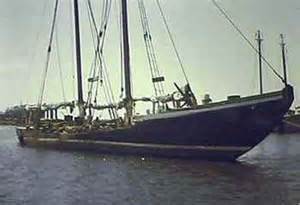
A snapper smack from the 19th century.
Photo: Brown Marine Pensacola
So what do we know about this “king of finfish”? Well, red snapper begin their lives like most fish, as planktonic larva. The larva first appear in northern Gulf around May and are found through November, with numbers peaking from July through September. Though they settle out from the plankton near hard structure, muddy bottom habitats appear to be very important as foraging grounds. Red snapper seem to stay close the hard structures they settle out near, though some movement does occur, particularly with snapper living deeper than 120 feet. They feed on zooplankton when they are young and move to a diet of small reef fish and crustaceans as adults; mantis shrimp are a particular favorite. Red snapper have been reported to live all most 50 years.
The problems with the fishery began in the mid 20th century. Though snapper were listed as overfished by the National Marine Fisheries Service their problems go beyond just overfishing. By-catch in shrimp trawls is a particular problem. Much research and money have been spent to solve this problem. Science has found that young snapper, typically caught in trawls, do not like bright light and experimental trawls with LED lighting have been tested; studies continue.

The king of finfish… the red snapper
Photo: Florida Sea Grant
In 1976 the Magnuson-Stevens Fisheries Conservation and Management Act was passed. By 1984 the first size and bag limits were issued and by 1988 the fishery was officially listed as overfished. Success at increasing numbers with the size and bag limits was low due to the shrimping by-catch issue and because many were not surviving the catch and release methods being used to return undersized fish. Studies show that snapper captured at depth experienced pressure problems as they are reeled to the service. This drastic change in pressure caused their swim bladders to expand, or rupture, a process known as barotrauma. Undersized (or over limit) fish had to be released. Those experiencing barotrauma were not surviving. Their expanded swim bladders would cause some to float – typically called “floaters” – and they were easy targets for sharks and dolphins. Others may descend slowly or reach the bottom but are still under stress and, again, were easy targets. Others still survived the release only to have issues with growth and immune function. Several techniques are used by fishing to reduce barotrauma, such as venting, but their success is debated and is currently under study.
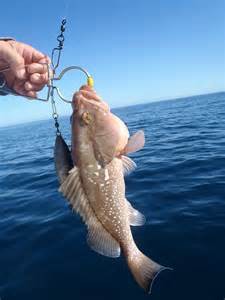
One of the many version of descending devices used by fishermen to return snapper to depth.
Photo: Florida Sea Grant
Despite management plans the fishery is still considered overfished. Solving the problem will require plans to deal with the by-catch and barotrauma issues but will also have to address the socio-economic issues of the management itself. Many families depend on this fishery for their livelihood and though a complete ban on the species for a period of time may be beneficial to the fish stock, it may not be practical. Researchers, fisheries managers, and others will continue to work on solving this problem and hopefully the “king of finfish” will be with us for a long time.
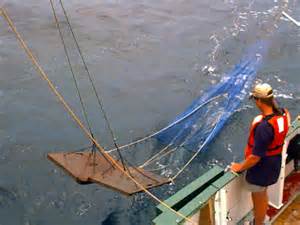
by Rick O'Connor | Oct 9, 2015
Shrimp… nothing says seafood along the Gulf coast like shrimp. It has been a staple part of our diet for decades; boiled, fried, steamed, stuffed, shish-kabobbed, As Forrest Gump said there are a million ways to cook shrimp and as Jack and Anne Rudloe mention their book, Shrimp, the Endless Quest for Pink Gold, there are many cookbooks dedicated to preparing one of the most popular seafood species.
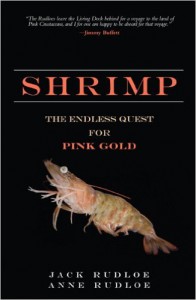
The book published by jack and Anne Rudloe in 2010.
Growing up in Pensacola I remember the shrimp boats lining Palafox Street at the Bayfront Auditorium. You could drive down with your cooler almost any day and purchase white or brown shrimp for $2-3 a pound. The boats were beautifully painted with red and blue colors. Their coolers were full and we would fill ours, take them home, de-head them, and then have to decide how we wanted to prepare them… fry? Shrimp and grits? Boiled? They were college football tail gating food, birthday celebrations, and I cannot remember a wedding reception I went to, including my own, where shrimp was not served in some form or fashion. It’s a great product, taste great, and good for you. Bu things are changing…
Locals along the panhandle might be surprised that shrimping, as we know it, did not begin here. Many who think of “shrimping” immediately think of Louisiana, Mississippi, and Alabama. Old wooden boats with nets draped everywhere and the familiar sound of the diesel engine in the early morning silence as they bring in the evenings catch. But according to the Rudloe’s commercial shrimping began in California. In their book they describe the evolution of the shrimping industry. Shrimp were in abundance in early human history, and relatively easy to catch. Archeologists assume they consumed large quantities of them but their chitonous shells do not preserve well so we are not sure. There are preserved nets from that time period which probably captured shrimp along with other small nearshore species. They were harvested in Europe, Africa, and certainly Asia using both nets and traps.
As these cultures came to the New World they brought with them the methods of capturing. Native Americans too used weirs and traps to collect. But it was Chinese who came to San Francisco during the gold rush that brought the idea of pulling nets behind their Chinese Junks and small shrimping villages began to pop around the Bay area. Though Cajuns had been shrimping in the Gulf before the Declaration of Independence was signed using beach seines, trawling behind boats did not come until later. At first these earlier shrimpers used sailing schooners and hauled the nets by hand but eventually the internal combustion engine arrived and both boat and winch power made the job easier and they could stay our longer. Dried shrimp was how the product was sold at first but the introduction of refrigeration meant shrimp could be brought in fresh, and the laundry list of how to prepare began. The amount of shrimp demanded stronger vessels, they switched from wood to steel and fiberglass vessels, and stronger power to pull these large nets, and they switched to diesel. With better vessels and power they could drop more than one net, shrimp boats were now seen with double booms and they could move farther offshore.
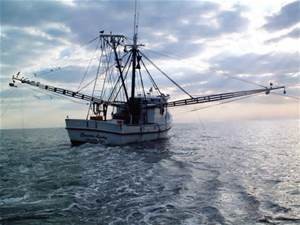
Shrimping.
Photo: NOAA
There are literally thousands of different species of shrimp in the world’s oceans but only a few are collected for food. In some cultures the small inshore species are the targets. Today some prefer the deep water ruby reds that could be collected only when the technology allowed. But most of us prefer shrimp from the Family Penaidae. White shrimp (gulf shrimp – Litopenaeus setiferus), brown shrimp (bay shrimp, “brownies” – Farfantepennaeus aztectus), and the pink shrimp (Farfantepenaeus duorarum) are the species locals enjoy. 90% of these three species sold are harvested from the Gulf of Mexico supporting, in some cases, whole communities. Then things began to turn “south”…
According to NOAA’s Fishwatch.gov the fishery is not currently being overfished. The problem with today’s shrimping industry is economic and environmental.
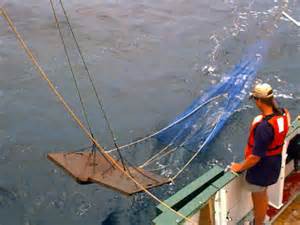
The basic otter trawl used for shrimping.
Photo: North Carolina State University
Economically, the cost of diesel has increased and for a 12,000 gallon vessel can cost the fishermen $50,000 per trip.
Bartering with wholesalers, many shrimpers will make 45% of their annual income in the first 45 days of the shrimping season, making tough times down the road – literally a “boom-bust” business.
Aquaculture… farmed raised shrimp has been around for centuries and the increased demand for the product many have turned to farmed shrimp to keep cost down. Many will be surprised to learn that 80-90% of the seafood consumed in the United States is farmed product from overseas. These low prices are difficult for the traditional ocean harvesting shrimper to compete with. You may also not know that a large amount of the product farmed overseas is not allowed to enter into the United States because of their method of using hormones to accelerate growth.
Environmentally, the trawl… As they drag their nets across the bottom they remove a lot of marine life in addition to the target species of shrimp. The otter trawl is opened using wooden doors and is pulled along the bottom using a chain (known as a “tickler”) to force the buried nocturnal shrimp to “pop up”. Trawled over seagrass beds they can do a lot of damage. Some studies have shown that almost 60% of the catch is what has been termed “trash fish” or “by-catch”. The Ocean Conservancy reports that after the World War II, when technology significantly improved for shrimpers, the by-catch to shrimp ratio was 4:1. Pressure from environmental groupers and other fisheries forced regulations on when, where, and how trawling would occur in attempts to reduce by-catch and damage to sensitive bottom habitat.
Sea turtles… one of the by-catch species were the federally protected marine turtles. This forced a change that required a Turtle Excluder Device (TEDS) to be installed into the trawl.
The oil spill… shrimpers certainly suffered from this incident and 10 years later in many parts of the Gulf the problems still exist.
We of course cannot forget “Mother Nature”. Hurricanes can change the ecology of the system enough to decrease available shrimp for several years.

The famous Gulf Coast shrimp.
Photo: Mississippi State University
All in all these economic and environmental issues have forced many out of the business. A few years ago the shrimping fleet in Pensacola numbers between 40 and 50 vessels, today there are about 10. Times are hard on the traditional shrimper… but despite these setbacks it still remains one of the more popular seafood species.

by Rick O'Connor | Oct 2, 2015
While directing the Marine Science Academy for the Escambia County School District I had students conduct small, informal, surveys targeting the popularity of seafood with students, parents, and the community. The purpose of these surveys was to kick start a discussion on the commercial fishing issue. The northern Gulf Coast has been known for several popular seafood products over our history; oysters, blue crab, mullet, snapper to name a few. There are two basic paths a commercial fishery can move as they grow their business. Fish for what they know and is easily harvested and convince the public to purchase – marketing. OR they can find out what the public wants and then develop a fishery to target those species. Hopefully they will find common ground; something that is available, easy to harvest, and popular with the public.

There are about 80 species of commercial seafood products that come from Florida.
Photo: Florida Sea Grant
In those surveys we looked at young and old, male and female. A couple of trends became apparent over the 20+ years we conducted these (remember, low level high school survey… but still interesting). (1) Shrimp was the no.1 favorite with all groups. That’s good, shrimping in the northern Gulf is a do-able product – many will say the best shrimp comes from these waters. But we also know that shrimping has hit hard times; more on this next week.
(2) With males No.2-5 are typically fish, with females it varies from fish to calamari, to sushi, to other. Popular fish of course are grouper and snapper… and we all know the issues with these target species in our area. There are lesser known fish with the general public, though many locals know, such as sheepshead, tilefish, pompano, that are not typically on menus. And of course a local favorite… mullet. With the mix request beyond fish include squid, crab, sushi grade fish, lobster, and others. Some of these are not common in our area and must be transported in. For many where the fish comes from does not really matter – for others it does (more on this in our last addition this month). But as you can see this type of information plays a role on how the seafood business works in the northern Gulf.
(3) The first question on the survey was “do you like seafood?” Of course if the answer was no then it was not necessary to ask further questions. The trend we saw over time was more and more stating they did not like it. Curious… I mean there are things I do not like either – so there is no problem not liking seafood – but we were curious as to why… so we added that to the survey. Our thought as we began was seafood safety. At the time much of the seafood landed was sold at a wholesale or retail market with little or no inspection – did this concern folks? In our survey we found that in most cases it did not. They just did not like the taste… fair enough.

Shrimping.
Photo: NOAA
What do the bigger surveys say? In 2014 an article was posted in the Wall Street Journal discussing this issue and what other surveys found. (1) There was a decline consumption. In 2012 Americans consumed an average of 14.4 lbs of seafood/person. This was down from 15.0 lbs in 2011 and 16.6 lbs in 2004. For comparison, at that time Japanese consumed 120 lbs/person/year and Spain consumed 96 lbs. To compare this with the “big three” at that time Americans consumed 46 lbs of pork, 57 lbs of beef, and 82 lbs of chicken/person/year. Chicken is king… it is a white meat, Americans are trying to eat healthier, but fish is a white meat… so why not fish?
The surveys indicated the top reasons were
- Do not know how to cook
- The price of seafood is high
- Marketing – the seafood industry is fragmented and marketing efforts on the healthy benefits have not happen (or if done, were not done as well as the focused effort of the chicken industry).
To a lesser extent there was concern over safety (particularly mercury) and some concern about genetically modified farm raised fish (salmon in particular was mentioned). Members of the chicken industry highlighted the cost of production for seafood as a barrier for them. It cost more to go to sea and harvest seafood (or raise salmon in ocean pens) than it does to produce the “big three” on farms.
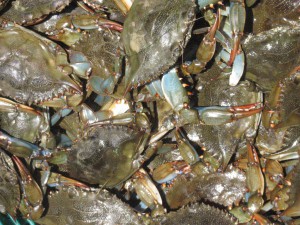
The crab of choice in the northern Gulf of Mexico; blue crab.
Photo: FWC
This year Florida Sea Grant published an article in the September issue of Florida Trends on this issue. Sea Grant pointed out that currently the national consumption of seafood is up to 15 lbs and that Floridians consume 31 lbs/person/year… so there is a trend upwards since the Wall Street Journal’s 2014 article. However 40% of Floridians do not consume 2 servings a week (as suggested by the U.S. Department of Agriculture).
We can state that seafood is healthy for you and it is safe to consume (check out Florida Sea Grant for more on this). What I am finding is that there is a small group of locals now concerned with whether the seafood they are consuming is coming from local fishermen. We will discuss more on these topics in later editions.
Enjoy seafood.

by Rick O'Connor | Sep 24, 2015
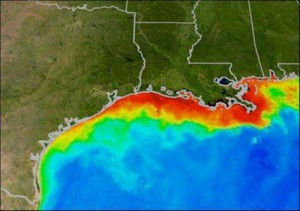
The red area indicates where dissolved oxygen levels are low.
I don’t want this to sound like a “Debbie Downer”… but there are problems with our estuaries and panhandle residents should be aware of them. There are things you can do to correct them – which we will discuss in the final issues of this series – but you need to understand the problem to be able to solve it. Unfortunately there are many issues and problems our bays and bayous face and we do not have time in this short article to discuss them all, but we will discuss some.
We’ll start at the top… with our rivers. Since the founding of our nation many communities were built on estuaries; those that were not were built on the rivers. Water was an easy way to move throughout the country – much easier than wagon crossing over the Appalachians or through a bog. There are several communities that developed along the rivers that feed the panhandle bays. Though the situation has improved in the last few decades, most of these communities have used these rivers as a place to dump their waste. Assorted chemicals, sewage, and solid waste were discharged… and it all came down to us. The Mississippi River is an example of this problem. Discovered in the 1990’s the Louisiana Dead Zone is an area in the Gulf where the levels of dissolved oxygen are so low that little or no life can be found on the ocean floor there. It is believed to be trigger by nutrients, chemical fertilizers and animal waste, being discharged upstream. These nutrients create a bloom of plankton, which can darken the water. Though the phytoplankton can produce oxygen during the daylight hours, they consume it in the evening, lowering the concentration of dissolved oxygen within the water column. The plankton are relatively short lived and eventually die. As the dead plankton fall out to the seafloor bacteria begin to decompose their bodies thus dropping the dissolved oxygen levels further. When the dissolved oxygen concentrations drop below 4.0 millgrams/liter we say the water is hypoxic (low in oxygen). Many species of aquatic organisms begin to stress. At 2.0 mg/L many species will die and we have a “dead zone”. If it reaches 0.0 mg/L we say the water is anoxic (without oxygen). This process is called eutrophication and not only a problem at the mouth of the Mississippi River, it occurs in almost all of the bays and bayous of the panhandle and is the primary cause of local fish kills.
A more recent issue with our rivers has been the reduction of water. In the so called “Water Wars” the state of Georgia has used its damn system to block the flow of the Chattahoochee River to create electricity and a reservoir of drinking water for river communities. Under normal conditions this has not created a problem however in recent years the southeast has experienced drought and the state of Georgia has had the need to hold back water for large communities – such as Atlanta. This has reduced the amount of water flowing towards the Gulf and has impacted communities all along the way. It is not the only issue but is the primary factor triggering the collapse of the oyster industry in Apalachicola. The reduced freshwater flow has increased salinities in the bay. This has disrupted the life cycle of the eastern oyster and has increased both predation and disease within these populations. Apalachicola produces over 90% of Florida’s oysters and 10% of the oysters for the entire country! Oysters are a huge industry in this town. Many are oystermen and many others process the product when it is landed… the industry is on the verge of collapsing. (Learn more).
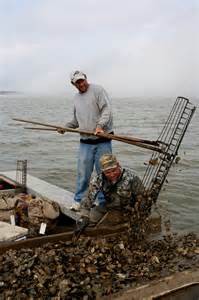
Oysterman on Apalachicola Bay.
Photo: Sea Grant
These are just some the issues stemming from the rivers… what about the issues initiated from the communities that live along the bay…
How about the seafood? We discussed the oyster industry in Apalachicola Bay but oyster production in other local bays has declined as well (for other reasons). Scallops are gone from many of their historic estuaries, shrimp and blue crab landings are down, this year mullet seem to be hard to find. What is going on here? For the most part the decline in seafood products can be tied to either a decline in water quality or from over harvesting. The harvesting issue is easy… do not harvest as much. However these fisheries management decisions impact many lives and has caused a lot of debate. First you need to determine whether the decline is due to overharvesting or some other environmental factor… easier said than done. Certainly the biology of your target species will give you an idea of how many animals you can remove from the system and sustain a healthy population (maximum sustainable yield) but this method has triggered debate as well. Most fishermen do not want to see the fishery collapse and are willing to work with fishery managers to assure this – but they do have bills to pay. Fishery managers have a responsibility to assure the fishery remain for current and future generations of fishermen and they are basing their decisions on the best available science. It is a touchy subject for many and a problem within our estuaries.
The other cause of declining seafood is poor water quality. You can talk to any “ole timer” and they will tell you about the days when the water was clearer, the grass was thicker, and the fish were more abundant… what happen? I spoke with my father-in-law before he passed away about the changes he saw in Bayou Texar in Pensacola. He remembers being able to see the bottom, more seagrass, and being able to catch a variety of finfish as well as shrimp the size of your hand. The first change he remembered was a change in water clarity… it became murkier… and this happen about the time they began to develop the east side of the bayou. As our communities grew more land was cleared for development. The cleared land allowed more runoff to reach the creeks, bayous, and bays. Infrastructure had to be placed to reduce flooding of yards and streets – Bayou Texar has 38 storm drains. All of this led to more runoff into our water ways. With the increase in turbidity the amount of sunlight reaching the bottom was reduced and seagrasses began to decline. Many species of seagrass require salinities of 25 parts per thousand or higher and the increase in freshwater runoff lowered the salinity which also stressed these grasses. Much of this runoff included sand and silt and the grasses were basically buried. All in all seagrasses declined… and with them many of the marine creatures. Salt marshes were removed for coastal developments, industries were located on our rivers and bays and introduced their chemical discharge, and boating activity increased… our estuaries were being literally “loved to death”. I have seen in my lifetime the decline of sea urchins and scallops from our bay, the increase in turbidity, and the decline of seagrasses. But we cannot blame all of this on habitat loss and pollution. Speaking recently with fisheries managers they believe the recent decline in blue crab landings is due to drought. Reduction in rainfall means reduction in river discharge, which means an increase in salinity and a disruption of the crab reproductive cycle.
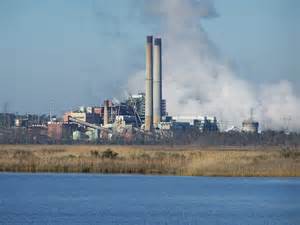
Power plant on one of the panhandle estuaries.
Photo: Flickr
Another problem that is associated with runoff has been the increase in bacteria. Fecal coliform bacteria are found in the stomachs of birds and mammals. They assist with our digestion and are released into the environment whenever we (or they) go to the bathroom. So finding fecal coliforms in the water is not unusual… the problem is TOO many fecal coliforms. As mentioned coliforms are not a threat to us but they are used as an indicator of how much waste is in the water. Feces harbors many other microbes in addition to coliforms – hepatitis and cholera outbreaks have been linked to sewage in the water. So agencies monitor for these each week. Most agencies will monitor for E. coli when sampling freshwater and Enterococcus in saline waters. E. coli values of 800 colonies / 100 milliters of sample or higher, and Enterococcus values of 104 colonies / 100 ml of sample will trigger a health advisory being issued – and some bodies of water being closed. In the Pensacola area the Florida Department of Environmental Protection and the Escambia County Health Department both monitor for bacteria. They post their results each week and I, in turn, post to the community. Our local bayous are averaging between 8-10 advisories each year. The problem with these advisories is that residents who live on the waterways, businesses (such as hotels and ecotours) who use the waterways become concerned about entering the water. It is not good for business or property values if the body of water you are on has high levels of bacteria and signs posting “no swimming”.
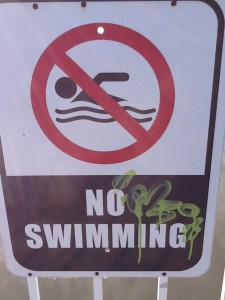
Closed due to bacteria.
Photo: Rick O’Connor
There are many problems our estuaries are facing but for this article we will end with solid waste. Trash and garbage has been a problem since I can remember. Campaigns have been launched each decade to try and reduce the problem but the problem still exist. Plastics and monofilament litter the beaches and waterways creating problems for marine life and an “eye soar” for those enjoying the bay. I am currently working with the Wildlife Sanctuary of Northwest Florida and CleanPeace to monitor solid waste in Pensacola Bay. Each week CleanPeace host a Saturday event they call “Ocean Hour” where they select a location on the bay and clean for an hour. They submit the top three items to me each week and have been doing this since January… it has been pretty consistent… cigarette butts, plastic food wrappers, and plastic drink containers. We are not going to get rid of garbage on our beaches but if we can consistently reduce the “top three” we should be able to reduce the problem.
More on what we can do to help in the final issue.

by Rick O'Connor | Sep 20, 2015
Yea, seafood… who doesn’t like seafood… actually, based on a small scale survey I conducted with marine science students over the last 28 years I have found a slight increase in the number of those who do not. Curious about this, I followed up by asking whether their concern was seafood safety or other. Almost all said they just did not like the taste. Okay… I can take that… there are something I do not like either BUT I LIKE SEAFOOD. The survey also showed that almost every year with young/old or male/female – shrimp was at the top of their favorite list. After shrimp the next 3-4 choices for males was some type of fish. For females it varied – fish, lobster, calamari, to name a few.

Shrimping depends on healthy estuaries.
Photo: NOAA
So what does this have to do with estuaries…
Well, you may not know this but 90% of the commercial important marine species require estuaries for at least part of their life cycles. Just as humans select a neighborhood to live and raise their kids based on safety and schools – “fish parents” find everything they want for their “kids” in an estuary. They are shallow – allowing light to reach much of the bottom where submerged plants, like seagrasses, can grow. These seagrasses provide hiding places and a place for small algae to attach – which is an important food source for many of them. There are other places for them to hide as well – emergent salt marshes and oyster reefs are biologically very productive habitats. Many of the developing larva and juveniles require lower salinities to begin and complete their life cycles; venturing to the open Gulf only when they have developed a tolerance for the higher salinities. The freshwater discharge not only lowers the salinity it also brings nutrients. These nutrients, along with the sunlight reaching much of the water column, produce an abundance of microscopic plankton – food for the young. The nutrients, thermal mixing, low salinities, and variety of habitats provide a combination for one of the most biologically diverse ecosystems on the planet – a great place to grow up… and much of it we enjoy eating.
Most of what we consume in the seafood world is divided into shellfish and finfish. Some of it is harvested and sold commercially, some we collect recreationally. In the shellfish world we are talking mollusk and crustaceans – two of the most popular seafood groups on the planet. The mollusk include snails, oysters, clams, mussels, scallops, and cephalopods like squid and octopus. Many of these species live in our estuaries their entire life cycle. Most are slow moving creatures – if they move at all – and have provided a living for some humans, recreation for many, for decades – though the landings of these species are on the decline… more on this in a later issue.

Oysters are one of the more popular shellfish along the panhandle.
Photo: FreshFromFlorida
Crustaceans include the ever popular gulf shrimp. We actually have three different species of bay shrimp we like – white, brown, and pink shrimp. There are other varieties found offshore we are now consuming, but these have been the big three. Blue crab – my personal favorite – is another popular crustacean. Though these are still harvested commercially, “crabbing” with your kids is a long time popular panhandle activity – and the day always ends well with a great meal. Crustaceans are more mobile and conduct small migrations during their life cycles. Shrimp develop within the estuary and then move offshore for breeding where the incoming tide brings the larva back to the estuary. Blue crabs migrate to the head of the bay for breeding and the females return to the lower end of the estuary for egg development and larva release – they may enter the Gulf during this process but tend to stick to the bays for the entire cycle.

The famous Gulf Coast shrimp.
Photo: Mississippi State University
In the finfish world we are talking drum, snapper, grouper, trout, whiting, mullet, flounder, sheepshead, and many more. These species have provided both a living for the commercial fishermen and recreation for families for years. Many species breed and grow within the estuary while others make trips in and out of the bay to complete their cycles. In addition to commercial and family recreation charter fishing has increased as a business along the Gulf coast.
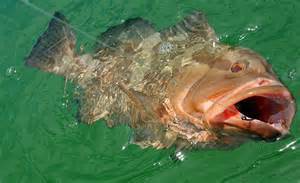
One of the more popular finfish – the grouper.
Photo: Bay County Extension, UF IFAS
We hope you and your family enjoy local seafood from our bays. There are several websites and apps, such as Seafood@Your Fingertips, that can help you locate local seafood – or you can go catch some yourselves! If harvesting recreationally be reminded that there are regulations and licenses required. You can read more about those at MyFWC.com.






















